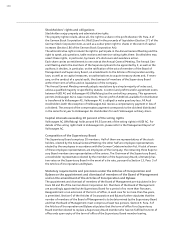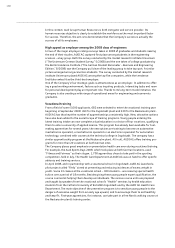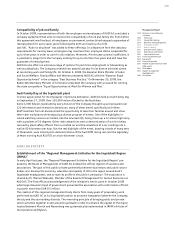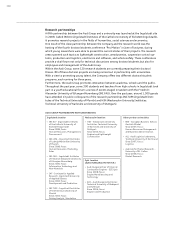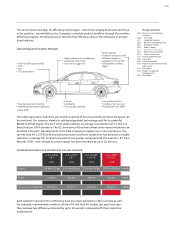Audi 2008 Annual Report Download - page 156
Download and view the complete annual report
Please find page 156 of the 2008 Audi annual report below. You can navigate through the pages in the report by either clicking on the pages listed below, or by using the keyword search tool below to find specific information within the annual report.
137
Management Report
128 Business and underlying
situation
128 The Group
131 Corporate steering
134 Research and development
136 Employee matters
139 Audi in society
141 Environmental aspects
147 Economic environment
150 Course of business
157 Financial performance
159 Net worth
160 Financial position
160 Report on post-balance sheet
date events
161 Risk report
165 Report on expected
developments
169 Disclaimer
As a result of continuing corporate growth, the workforce of AUDI AG itself grew by 1,391
employees, a large proportion of them engineers. As of January 1, 2008, AUDI AG assumed
management responsibility for AUDI BRUSSELS S.A./N.V. (Brussels, Belgium), thereby consoli-
dating it within the Audi Group. In the first year of its inclusion in the Group, on average 2,134
employees were employed. At the Hungarian subsidiary AUDI HUNGARIA MOTOR Kft., the 5.4
percent growth in human resources can first and foremost be attributed to higher vehicle manu-
facturing output. The number of employees at the Lamborghini Group (excluding VOLKSWAGEN
GROUP ITALIA S.P.A. and VOLKSWAGEN GROUP FIRENZE S.P.A.) rose to 989 (933), again thanks
to its increased business volume. The workforce of VOLKSWAGEN GROUP ITALIA S.P.A. (exclud-
ing VOLKSWAGEN GROUP FIRENZE S.P.A.) in the past fiscal year was slightly down year-on-year.
The average age of employees at the Audi Group’s manufacturing locations edged up slightly
from 39.9 to 40.0 in 2008. At approximately 15.7 years, the average length of service also
remained more or less unchanged. Women accounted for 11.7 (11.8) percent of the workforce
at Audi Group production sites.
At the very beginning of 2008, AUDI AG announced plans to recruit new personnel, above all in
the engineering professions. Around one-third of the AUDI AG workforce are now college gradu-
ates, an increase of 1.6 percentage points on the previous year.
The proportion of foreign nationals employed by AUDI AG fell slightly to 8.2 (8.5) percent.
The severely disabled continue to perform a meaningful role at AUDI AG, accounting for
5.3 (5.4) percent of the workforce in 2008. The volume of orders placed with workshops for the
mentally disabled grew by over 20 percent to around EUR 4.5 million in the past fiscal year.
AUDI AG remains at the vanguard of German industrial enterprises in terms of industrial safety.
The accident index shows a downward trend which has now lasted over 20 years. Again in 2008,
both the frequency and severity of accidents were lower than in the prior-year period.
The attendance record for AUDI AG remained very high at 97.0 (97.0) percent. This outstanding
result was made possible by continually improving the workplace organization and introducing
numerous preventive health-care initiatives.
Over 33,000 ideas were submitted in 2008 as part of the AUDI AG suggestions scheme. Of
these, 56.8 percent were acted upon. The Deutsches Institut für Betriebswirtschaft (dib) voted
AUDI AG’s suggestions award program as the best in the car industry for the fifth time in a row
(March 13, 2008).
The Audi Group’s human resources policy
The Audi Group’s human resources policy is instrumental in helping the Company achieve its
strategic goal of becoming the most attractive employer. The focus here is not only on getting
positive image ratings in surveys among graduates and young professionals, but also on estab-
lishing good relationships with employees. Personnel development is therefore a key priority.
Three conditions must be met in order to successfully develop a person’s career: There must be
opportunities to develop through learning and optimizing skills (competence development),
opportunities to assume growing responsibility and autonomy (career development), and the
individual must receive proper consideration for performance and commitment (pay develop-
ment and profit sharing). Activities in these three areas must be so organized as to meet the
challenges of intensifying competition.
The Company has therefore set the following priorities for its human resources policy over
the next few years. One is to use extensive competence management in meeting the growing
demand for specialist and cross-specialty competences, thus satisfying the requirement for
lifelong learning. Next, personnel development for standard-wage employees is to be organized
through the introduction of a new system of succession planning. The third priority area is han-
dling demographic change, which the Human Resources area is tackling as part of a broader
concept. This concept encompasses everything from the organization of working conditions to
training and management measures. What is important here is not just that an employee’s age
is addressed, but that the whole process of aging itself is taken into consideration.





